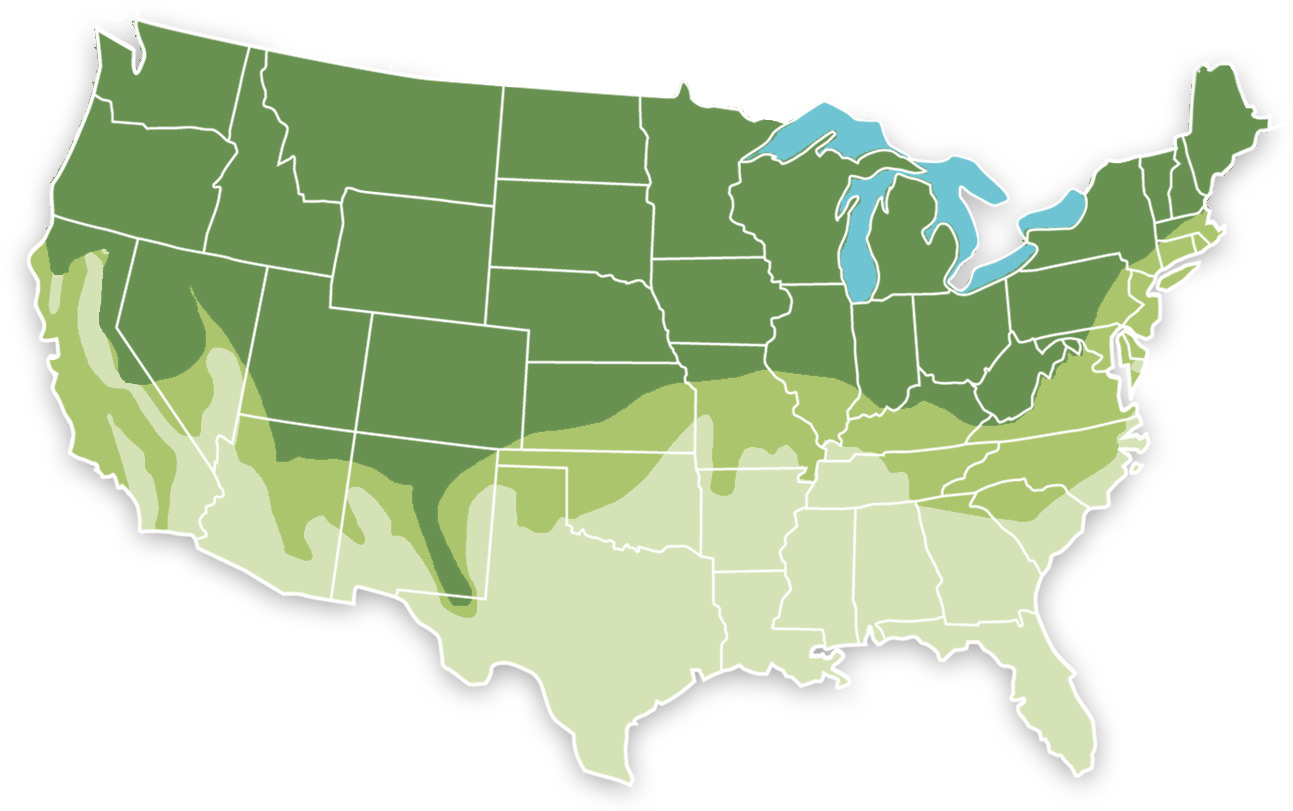No Mow Planting Zones, Conditions & Seeding Rates
The cool-season grasses that comprise No Mow Lawn Seed mix are recommended for planting in areas at approximately 37 degrees North Latitude and higher. No Mow is also adapted to the coastal areas of the Pacific Northwest, the cooler mountain climates in the east-central states, and in the western mountains from the mid-elevation aspen woodlands to just below timberline.




Recommended Zone. Best suited to cool season grasses such as the fine fescues in No Mow.


Transition Zone. Suitable for either cool or warm season grasses. No Mow performs well in this area, with the exception of hot drought-prone sites such as south-facing hillsides, or very dry rocky or sandy soils.


Not Recommended. Hotter climates are best suited to warm season grasses that can tolerate long, warm summers.
Recommended Seeding Rates
Lawns: 5 pounds per 700 sq. ft.<br>or 300 pounds per acre
Low maintenance areas: 5 pounds per 1400 sq. ft. or 150 pounds per acre
Areas that are intended to be low maintenance (fields, orchards, pathways) can be seeded at half the lawn-seeding rate. Seeded at half the rate, the turf will take longer to develop, but will typically fill in to form a sod within one full year.
When to Seed
Fall is the optimal window for seeding No Mow. We recommend seeding sometime between the end of August (after Aug 20) and mid October (before Oct 20). Cool season grasses that are seeded in fall experience much less weed competition than spring seedings, mature faster, and should form a sod by the end of the following spring. No Mow can also be seeded in early to mid-spring, between March 15 and May 15, but spring seedings will experience greater competition from weeds, and will usually require more watering as the temperatures rise going into summer.
With cool season grasses, germination typically halts or is greatly reduced once the daily temperatures reach around 80 degrees Farenheit. The seeds may remain viable and germinate in later summer when temperatures drop. However, a summer-seeded No Mow mix is easily out-grown by warm season weeds and grasses which create significant competition for newly-germinating No Mow seedlings that may finally appear in September. A No Mow Lawn should not be seeded in the summer.
Germination
No Mow seed will generally germinate within 10 – 14 days after the first watering or rainfall event.
Site Conditions
SOIL CONDITIONS
No Mow thrives on any reasonably well-drained soil, and is particularly well suited to growing on dry, sandy or rocky soils with low Nitrogen levels. No Mow is not recommended for damp soils, or heavy clay soils with less than four inches of rich loamy topsoil.
LIGHT CONDITIONS
No Mow thrives in full sun, and is also very shade tolerant. It does particularly well under individual trees that receive indirect light from the sides, and is an excellent choice for around surface-rooted trees that leave little available soil for turf. It thrives in woodlands composed of oak, hickory, elm, ash, birch, white pine, and other “open canopy” tree species that allow filtered light to reach the ground level. No Mow will grow under spruce trees that receive light around their edges, provided that the surface layer of needles and duff are removed to expose the mineral soil prior to seeding. When planted under deciduous trees the leaves must be raked off or thoroughly chopped up with a mulching mower after autumn leaf fall to prevent smothering of the turf grasses over winter. No Mow will not perform well in deep shade, as occurs under Sugar Maples and dense stands of conifers.
RAINFALL REQUIREMENTS
No Mow does best in climates that receive annual precipitation of 25 inches or more, with at least half arriving during the growing season. In drier climates with less than 25 inches of rain, supplemental irrigation can be supplied during dry periods in summer. No Mow is more drought tolerant than Kentucky Bluegrass, making it an excellent alternative for cool, arid climates. While it is an extremely drought tolerant grass blend, No Mow will not survive extended droughts.
SOIL pH RANGE
The fine fescues in the No Mow Lawn Mix grow well in soils within a pH range of between 5.0 and 8.0. The optimum pH range for these grasses is between 5.5 and 6.5, but will thrive in a wide range of soil acidity and alkalinity.
Next article: No Mow Lawn Seeding Instructions







